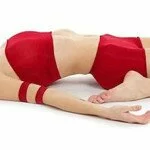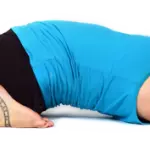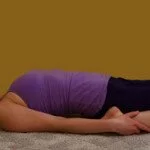Supta Virasana (Sanskrit: सुप्तवीरासन; IAST: suptavīrāsana) or Reclined Hero Pose is an asana.
The name comes from the Sanskrit words supta (सुप्त) meaning “reclined” and asana (आसन; āsana) meaning “posture” or “seat”
Supta Virasana is a reclined version of virasana where the upper body reclines backwards, so that the back rests on the floor. The arms rest on the floor to either side of the trunk, with the palms facing up.
Anatomical focus:-
Lengthens the extensor muscles of the leg and the deep psoas muscles that connect the legs to the trunk.
Contraindications and cautions:-
With knee conditions and during menstruation with excessive bleeding it may be contraindicated to practice Supta Virasana.
Variations:-
Eka Pada Supta Virasana (One-Legged Reclining Hero Pose) or Ardha Supta Virasana (Half Reclined Hero Pose)) involves one leg folded under the body while the other is being stretched
Step by Step:-
- Perform Virasana. Exhale and lower your back torso toward the floor. First lean onto your hands, then your forearms and elbows. Once you are on your elbows, place your hands on the back of the pelvis and release your lower back and upper buttocks by spreading the flesh down toward the tailbone. Then finish reclining, either onto the floor or a support.
- If your front ribs jut up sharply toward the ceiling, it’s a sign of tight groins, which pulls your front pelvis toward your knees and causes your belly and lower back to tense. Use your hands to press your front ribs down slightly and lift your pubis toward your navel. This should lengthen your lower back and lower it toward the floor. If it doesn’t, raise yourself onto a higher support. Then lay your arms and hands on the floor, angled about 45 degrees from the sides of your torso, palms up.
- Sink the heads of the thighbones deep into the back of the hip sockets. It’s alright to lift your knees a little away from the floor to help soften your groins; in fact, you can raise your knees a few inches on a thickly folded blanket. You can also allow a little bit of space between your knees as long as your thighs remain parallel to each other. Do not, however, allow the knees to splay apart wider than your hips – this will cause strain on the hips and lower back.
- To begin, stay in this pose for 30 seconds to 1 minute. Gradually extend your stay to 5 minutes. To come out, press your forearms against the floor and come onto your hands. Then use your hands to lift your torso into Virasana. As you come up, lead with your sternum, not your head or chin. Come out of Virasana in the recommended manner.
Therapeutic Applications:-
- Arthritis
- Asthma
- Diarrhea
- Digestive problems
- Flat feet
- Head cold
- Headache
- High blood pressure
- Infertility
- Insomnia
- Intestinal gas and acidity
- Menstrual discomfort
- Respiratory ailments
- Sciatica
- Varicose veins
Benefits:-
- Stretches the abdomen, thighs and deep hip flexors (psoas), knees, and ankles
- Strengthens the arches
- Relieves tired legs
- Improves digestion
- Helps relieves the symptoms of menstrual pain
Beginner’s Tip:-
If your thighs insist on sliding apart in this pose, you might try one of two short-term solutions: bind your thighs together with a strap positioned around the mid-thighs; or squeeze a 2- to 3-inch thick book between your thighs. In either case be sure to draw your inner groins sharply up into your pelvis.
Preparatory Poses:-
- Baddha Konasana
- Balasana
- Bhujangasana
- Gomukhasana (leg position)
- Virasana
Follow-Up Poses:-
Like its upright cousin, Supta Virasana is an excellent preparatory pose for many asanas, including Padmasana, Baddha Konasana, Bakasana, most standing poses, and any inversion and backbend.
Deepen The Pose:-
You can also involve the arms in this pose. Inhale and raise your arms toward the ceiling, parallel to each other and perpendicular to the floor. Rock back and forth a few times, further broadening the shoulder blades across your back, then stretch your arms overhead, on the floor, palms up toward the ceiling. Rotate your arms outward, so the outer armpits roll toward the ceiling, and pull your shoulder blades down the back toward your tailbone.





